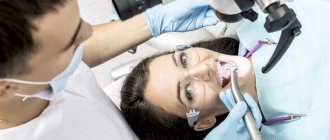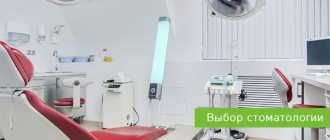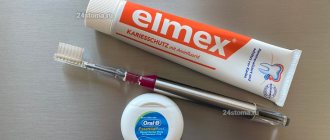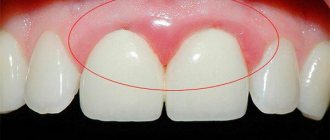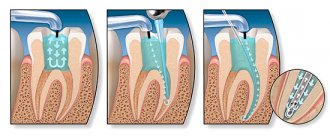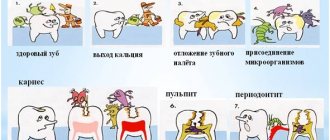Why are teeth drilled?
In dentists' language, drilling teeth means preparing. The doctor removes tooth tissue damaged by caries before placing a filling. However, teeth are drilled not only for treatment.
The tooth may be prepared to be covered with a crown. Prosthetics are needed if the doctor sees that restoring a tooth with a filling is unreliable. For example, when it is a front tooth and there is a risk of chipping due to increased load. Another reason is the small volume of healthy tissue. If the patient has deep caries, and even more so pulpitis, tooth restoration with a crown is indicated. In this case, the dentist drills the tooth in several stages. The doctor dissects it to remove caries-affected tissue to open the pulp chamber, gain access to the canals and widen them. At the last stage, after removing the nerve and treatment, the dentist drills the tooth, grinding it down for a crown.
The doctor is sometimes forced to dissect even healthy (without caries) and living (with nerve) teeth. This happens when veneers are placed. They are ceramic overlays for teeth. It happens that the front teeth are too small or there are large distances between them. It happens that a spot appears on a tooth due to fluorosis, enamel hypoplasia, or trauma. Sometimes a small part of the front tooth breaks off or the cutting edge wears off. There are simply very demanding patients when it comes to aesthetics. They want their front teeth to be the same shape, size and perfect appearance. In all these cases, installation of veneers is possible. Their advantage is that the tooth remains alive. It is not depulped and a small layer of enamel is removed (ground down).
Laser treatment
The impact on carious lesions is carried out using a laser beam that dissects hard tissue. The doctor selects the length of the laser beam to ensure the evaporation of carious areas. Healthy tissues are not affected. The laser wave stops the growth and reproduction of pathogenic microflora on the diseased tooth and in the oral cavity.
The technique is completely non-contact and therefore painless. After removing the damaged areas, the risk of further development of caries under the installed filling is minimal.
Important! Under the influence of a laser beam, the tooth does not vibrate, which eliminates the possibility of additional cracks and chips in the enamel.
Laser dental treatment
Dental practice involves several options for exposure:
- Contact. Tight fit of the emitter for deep penetration into tooth tissue. It is used for the treatment of pathological lesions, photophoresis and treatment of alveolar sockets.
- Contactless. Based on remote surface processing. The gap between the device and the tooth is about 8 centimeters. Used to relieve swelling, relieve pain, and external irradiation of carious lesions.
- Stable. Used if the pathological field does not exceed 1 cm.
- Labile. It is used for large areas of tooth enamel destruction. Based on point irradiation with movement at a speed of 1 cm/sec. according to the affected area.
Indications for laser use:
- caries;
- granuloma;
- periodontal disease;
- enamel whitening;
- treatment of tooth sensitivity;
- processing for prosthetics;
- correction of dental defects.
Laser operation system for dental treatment
The technique has a wide range of contraindications:
- Nervous diseases.
- Kidney diseases.
- Diabetes.
- Bleeding in the mouth.
- Severe damage to the heart and blood vessels.
- Hyperthyroidism.
- Tuberculosis.
- Pregnancy up to 8 weeks.
- Photodermatoses.
The caries treatment procedure consists of the following steps:
- Removing plaque from a tooth.
- Preparation of a carious canal with a laser beam.
- Sealing the canals.
- treatment of the treated surface with an adhesive solution.
- Installation of a seal.
- Crown modeling.
Laser dental treatment process
Reference! The cost of treating superficial caries using a laser ranges from 800 to 3000 rubles. Removal of deep lesions from 1000 to 10,000 rubles.
Drill teeth without pain
Some, especially the older generation, tell how they were treated without anesthesia not only for caries, but also for pulpitis. The doctor, by the way the patient twitched sharply, determined that the instrument had reached the nerve. Now everything is completely different. Anesthesia has become the standard in dentistry, with pain relief for both teeth drilling and extraction.
This is necessary, first of all, so that the patient in the dentist’s chair does not experience stress. Anesthesia also makes the doctor’s work more convenient. When the dentist just begins to dissect, it does not hurt the patient because there are no nerve endings in the enamel. But when the doctor approaches the enamel-dentin border, the person can jerk sharply in pain, and the dentist can damage the mucous membrane with the instrument.
Don't be afraid that the injection won't work. All modern anesthetics relieve pain equally well, and it does not matter how old a person is, what ailments he has or what medications he takes. A medicine can only “fail” if the doctor injects it in the wrong place. This happens either because the dentist is inexperienced, or because the nerve bundle runs slightly in a different place than usual. In such cases, they simply do it again in the right place.
Drilling teeth with an injection does not hurt. However, the patient feels the way the teeth are drilled, i.e., the vibration of the rotating instrument. The anesthetic blocks the type of nerve fibers that are responsible for pain. Completely different (proprioceptive) receptors are responsible for the sense of pressure and vibration. Fortunately, these sensations do not cause discomfort.
Why does it hurt so much when a tooth is drilled?
In fact, a tooth is not a bone, of course. A tooth is a whole living organ that contains a variety of types of tissue: enamel, dentin, cement, nerves and blood vessels. And the tooth itself sits in the socket and is held there by the periodontal ligament.
What can hurt there? Yes, almost everything except enamel! Enamel is the hardest tissue of the human body, and it does not contain nerve endings. She protects the tooth and takes on all the “blows of fate.”
Dentin is slightly less hard than enamel, but its composition is much more complex. Inside the dentin there are so-called dentinal tubules, which contain fluid. These tubules radiate directly from the dental pulp, so the movement of fluid within the tubules can cause pain.
The enamel-dentin junction is a very painful area. When the boron reaches it, then if the patient is not under anesthesia, then pain almost always occurs.
Needless to say, if the tooth is destroyed down to the pulp (neurovascular bundle), then any touch to it also causes very severe pain, because we are touching the very exposed nerve.
If the process goes even further and the pulp dies, then a purulent sac may form behind the top of the tooth, which forms a granuloma, and then a cyst. In fact, these are bags of pus, which, in case of inflammation, begin to expand and put pressure on the surrounding tissues, which causes severe pain.
Sometimes such a purulent sac breaks into the oral cavity and pus flows out of it, reducing the pressure. Then the pain goes away, and the process turns from acute to chronic. Pus is released, but does not put pressure on anything, but simply enters the oral cavity through a hole, and therefore nothing hurts during this period. The patient thinks that everything has passed, but in fact the process is in full swing, it’s just painless for some time.
Of course, having a chronic process in your mouth and feeding your body pus every day is, to put it mildly, not healthy, so you need to take urgent action.
All this, of course, is very, very simplified for people who do not have a medical education, but the essence is generally clear. There is something to hurt in a tooth at almost all stages of the development of the disease.
Therefore, you need to take care of your teeth and under no circumstances let a healthy tooth develop caries. If caries does form, then it needs to be treated as soon as possible so as not to develop pulpitis. If you have reached the point of pulpitis, then all the more you need to run for treatment as soon as possible, so as not to develop periodontitis, after which you often have to part with the tooth altogether.
Anesthesia
Let's look at what else people are afraid of when they hear about pain relief.
- Pain from the injection. There are patients, especially children, who are frightened by the very injection of an anesthetic with a syringe. Doctors know about this, so they pre-lubricate the injection site with anesthetic gel. It reduces discomfort to a minimum. But it must be said that a good doctor makes the injection almost unnoticed.
- Allergy to anesthetic. The likelihood of its occurrence is negligible, much lower than the likelihood of food poisoning.
- Short duration of action of the anesthetic. Some are afraid that the “freezing” will disappear before the dentist finishes the work and pain will appear. Indeed, the duration of action of an anesthetic injection may vary slightly from person to person. The anesthetic will “work” faster in those who have better blood circulation in the area of pain relief. These same patients are more likely to “come away” from the injection. A doctor cannot predict this, but a good specialist is always interested in the patient’s feelings. If the analgesic effect decreases, the dentist transfers the next stages of work to another appointment.
- Side effects of anesthesia. Sometimes patients complain that immediately after the injection their arms and legs begin to tremble, their heart rate increases, etc. This reaction is caused by adrenaline in some anesthetics. In this case, the doctor selects another drug, without adrenaline or with a reduced content of it. There are plenty of such options, they are also used for children. Occasionally it happens that due to “freezing” a person’s eye cannot close. Don't be alarmed: this will go away as soon as the anesthetic wears off. It's all about the proximity of the anesthetized nerve to the optic nerve.
Drill
Dentists twisted the first burs by hand (you can read about this in the article “History of Dental Treatment”). Then - with your feet. Then they entrusted this matter to electricity.
Nowadays, burs are rotated by compressed air, and it is pumped by an electric compressor.
No matter what modern drill is - with great speed and low vibration, with cooling - the tooth still heats up from the drill. This is why drilling is painful, and it is most often done with an anesthetic injection.
Sometimes patients say: there was a small hole, but when they drilled it out, it became huge. But this is not because the doctor is crooked. The thing is that tooth enamel is the hardest tissue of the body and is destroyed more slowly than the dentin that lies underneath it. The hole can actually be huge, but only a small dot is visible on the enamel, or nothing at all is visible if the caries is interdental .
In addition, there are rules for boron preparation. The doctor cannot remove less than required - the filling will fall out, or secondary caries .
Fear of the dentist is most often fear of the drill. There are people who are so afraid of it that they try to cure tooth decay themselves. They bite the rest of their teeth into the Internet and look for magical folk recipes there.
I have two news for them - bad and good. The bad: no matter what all sorts of “experts” say, it is impossible to cure caries without a dentist. Good: without a drill ! Read about it below.
How long does it take to drill teeth?
It must be said that dental treatment is not always possible in one visit. And the reason for this is not the slowness of the dentist, but the careless attitude or fear of the patient, because of which he postpones the visit to the doctor.
Caries, when there is no need to depulpate the tooth (remove the nerve), is treated in one visit. Pulpitis is treated in two visits. After removing the nerve and cleaning the canals, the dentist places a temporary filling, and a medical pad under it. The patient is released for about a week. The next time the doctor asks if the tooth hurt. If not, then the channels are cleaned well. They can be filled and the tooth can be restored with a permanent filling.
It happens that the patient has brought the tooth to periodontitis, that is, when the inflammation has already spread to the tissues around it. Then the dentist injects medicine into the canals. After a few days, repeat the procedure, and so on several times, until the inflammation disappears. Further treatment is the same as the treatment of pulpitis.
Restoring a tooth with a filling, even without pulp removal, can be lengthy. How long it takes to drill a tooth depends on the size of the carious cavity. It often happens that a tooth is affected from several sides, for example, on the chewing surface and in the interdental space. In this case, the dentist creates several cavities for fillings. A lot of time is spent making the tooth indistinguishable from natural, healthy teeth. This is why doctors prefer to call the treatment aesthetic restoration. Of course, you can drill out a tooth and close it with a filling in 5 minutes, but high-quality work, when attention to detail is paid, takes 30 or 60 minutes.
How is a tooth treated?
Let's consider the stages of caries treatment, i.e. the situation when the tooth remains alive (with a nerve) and the canals are not filled.
When the anesthetic has taken effect, a rubber dam is placed on the tooth. This is a thin elastic film that protects the tooth from saliva or gum fluid.
The dentist drills out all tissues damaged by caries and creates a cavity for the filling. He then applies the etchant to the tooth for 10 to 40 seconds. This is a substance (acid) that removes sawdust after drilling and makes the tooth surface rough for better adhesion.
After washing off the etching, the doctor applies fluoride varnish, which strengthens the dentin and reduces tooth sensitivity. The next step is to apply bonding. This is a substance for the ligament of the tooth with the filling, which penetrates the dentinal tubules. To make the bonding harden, it is illuminated with a helium lamp. Its rays are harmless, it is just a blue LED lamp.
To place a filling, the dentist needs several types of filling material because different parts of the tooth have different colors and translucencies. The doctor applies an opaque dentin-colored material and illuminates it. A transparent layer (enamel) is applied to the incisal edge and exposed. Next, the doctor, to make the tooth look natural, forms the longitudinal ribbing of the tooth (mamelons). If the tooth is chewing, it creates grooves (fissures) between the cusps. Lights it up, removes the rubber dam and polishes it. Grinding is necessary not only for the beauty and shine of the tooth, but also so that plaque sticks to it less.
Next, the dentist checks the height of the filling. He places special paper, similar to copy paper, on the tooth. The patient makes several chewing movements, and imprints remain on the teeth at the points of contact. Using them, the doctor determines whether the filling is too high or too low. Makes changes if necessary. If this is not done, the filling will interfere with chewing and the bite will be disrupted.
Features of children's treatment
If the parent himself is afraid of the dentist and scares the child with him, then visiting the doctor will be problematic. Show that you treat visiting the doctor as something routine. Tell them that all your relatives and friends go to the dentist. If possible, take your child with you to your appointment. Play treatment at home, don’t tell them how teeth are drilled, but count them, look at them in the mirror.
On the day of your visit to the doctor, do not be too affectionate and do not shower him with gifts. This will alert the child. Don't threaten punishment. Don't come too early, don't sit in the hallway, because the baby may get upset because of the crying children.
A good pediatric dentist will never drill a child’s tooth out of the blue. He will talk to the baby using the definitions available to him. For example, do not drill, but buzz, do not give an injection, but smear with cold ice cream, do not treat, but take out the worm from a tooth, do not put a filling, but cover it with chewing gum. Expensive private clinics even offer an adaptation service, where the doctor plays with the child, teaches how to brush teeth, etc.
Local anesthesia is required; the baby should not feel pain. But please note that the clinic must have a license for children's treatment. Different dentists approach general anesthesia differently. It can be avoided in 99% of cases. Sedation is justified if a child with a strong gag reflex is undergoing treatment of lateral teeth, if the child is uncontrollable, if the previous treatment caused him severe psychological trauma.
Sandblasting machine
There are several devices that allow you to remove caries with sand: Aquacut Quattro and AquaCare (UK), Sandman (Denmark), RONDOflex plus 360 (Germany).
Device for cleaning and preparing teeth Aquacut Quattro
They are also called kinetic or hydrokinetic. Of course, they do not use river or sea sand, but a special abrasive. In some machines it is poured from a large can, in others the abrasive is packaged in cartridges. These same devices, only with a different type of abrasive, can be used for professional teeth cleaning.
In order to more clearly explain the advantages of such devices, we need to go a little away from the topic.
Dentists, if possible, try to save the tooth pulp (nerve). When it is alive, the tooth receives with its help substances that maintain it in normal condition. If the pulp is removed, it darkens, becomes brittle and can collapse even from a small load. In addition, neither a granuloma nor a cyst will ever grow on the root of a living tooth, due to which you can lose the tooth.
Pulp is removed in several cases:
1. If this is necessary for prosthetics.
2. If the tooth has chipped down to the pulp due to injury. Most often this occurs due to impacts or stones in the food, but sometimes for more exotic reasons. For example, I know a man whose tooth was “shot off” with a traumatic pistol. As Vasily Alibabaevich said in the film “Gentlemen of Fortune”: “Why are you so angry? Why, like a dog?
3. The tooth did not break off, but due to a strong blow, the pulp became inflamed or died (pulpitis or periodontitis).
4. Caries (now called complicated) reached the pulp, it became inflamed and the tooth became sick (pulpitis). Or the inflammation has spread beyond the tooth – periodontitis.
5. Caries has almost reached her. In this case, due to heating of the tooth during treatment, there may be pulpitis. There is no fault of the doctor here - he just should have contacted earlier.
Inflammation of the dental pulp - pulpitis
Periodontitis
When deep caries is removed with sand, the probability of pulpitis is, of course, not zero, but it is much lower than when working with a drill, because the tooth does not heat up during preparation. And if they work with initial or intermediate caries, then it also doesn’t hurt. Pain relief is almost never needed with this method of work.
I heard from doctors who were “told by other doctors” that this is all nonsense and only superficial caries can be treated with sand. I know for sure that neither one nor the other even tried to work using this method. Because for ten years, three meters from my workplace, the Aquacut Quattro device was used to clean teeth and treat all types of caries. Personally, I was treated for deep caries (it happens - dentists are people too) without pain relief.
There are no special contraindications to this treatment. Unless you need to treat small children and asthmatics with caution - collect flying sand with a saliva ejector and a vacuum cleaner.
And if everything is so great, why don’t all clinics have such devices? So I’m surprised. I suspect that it has to do with two things – the conservatism of doctors and the cost of consumables.
Is it harmful to drill your teeth often?
Drilling teeth damaged by caries is not harmful, but necessary. Even a person who is careful about their oral hygiene may need treatment, and here's why. In the cervical areas, in the fissures of the lateral teeth, plaque accumulates faster due to limited access. In addition, the layer of enamel in these areas is thinner than, for example, on the masticatory hillocks. The emerging caries may not be noticeable to the patient, but it develops quite quickly.
It happens that a person sees a tiny dark spot on a tooth, and the doctor has to drill out a huge cavity and cover it with a large filling. How does this happen? The fact is that enamel is the hardest tissue in the body. Caries affects it more slowly than the dentin located along it. A small entrance hole in the enamel leads into a large cavity in the dentin.
If a person goes to the dentist because a tooth begins to hurt, it means that inflammation has begun, i.e. pulpitis. In this case, you will need to drill more. We can conclude that teeth are drilled more often in those who do not see a doctor on time or ignore preventive examinations.
What happens in the oral cavity when we don’t treat teeth:
- Caries begins to spread to neighboring teeth and can lead to tooth loss
- Inflammatory processes begin in the body
- Serious problems with the stomach and cardiovascular system occur
- A cyst forms, leading to blood poisoning or cancer
In addition to serious problems, patients begin to suffer from bad breath, psychological problems (uncertainty, tightness, constant stress) arising from the unaesthetic appearance of the dentition. That is why treatment under anesthesia is necessary even if the tooth does not hurt or cause discomfort, because it is not for nothing that they say: “it is better to prevent than to treat later.”
But, if you couldn’t avoid caries, try to treat it at the first signs, and don’t delay going to the doctor. In addition, modern dentistry in Minsk allows you to treat teeth not only without pain and fear, but even in your sleep. How? With the help of drug sedation. The Family Dentistry Center in Minsk offers its patients high-quality treatment under sedation. It is completely safe for the body and will allow even small patients to have their teeth treated calmly. All procedures are carried out under the supervision of anesthesiologists, and you do not experience any pain, fear or discomfort.
If you treat caries at the initial stages of its development, you will not even have to resort to the use of anesthesia, because the procedure can be painless, moreover, the cost of the filling will be lower, because less material is used. As for time costs, here you still benefit: filling a small hole in a tooth can take from 15 to 30 minutes, while treatment and installation of large fillings on the entire tooth can take about an hour. Everything will depend on the condition of the dentition and the degree of complexity of the operations performed.
Now you know why it is so important to treat caries, even if the tooth does not hurt. Avoid serious oral diseases and maintain dental health for many years - timely treatment will help cope with any problems. And, of course, do not forget about the rules of hygiene and preventive examinations at the dentist. The beauty of your smile is in your hands!
Expert advice
Before starting treatment, a good doctor always explains what he will do and why. Don't hesitate to ask your dentist anything you don't understand. A professional doctor is interested in caring patients. In addition, you must clearly articulate what results you expect from the treatment.
Describe your fears to the dentist. People are often afraid of the unknown, so the doctor should dispel doubts with his explanations, and also do everything to make you feel comfortable. If you trusted a specialist and agreed to treatment, then follow the doctor’s requests during the process.
Sometimes after filling there is a reaction to hot and cold. This is due to the fact that the filling material has a higher thermal conductivity than the tooth. In this case, the doctor uses a sealant. Another option is to wait; the sensitivity will decrease on its own over time. In six months everything will be as before. If after filling the tooth begins to react to acid, go to the dentist. This reaction indicates a leak in the filling.
Prevention of caries
A child who is teething needs to be seen by a pediatric dentist once. The doctor will check that everything is going as it should. Until the age of three, it is enough to come for an examination once a year. After three years, a child, like an adult, should visit the dentist twice a year.
Brush your teeth twice a day with a soft or ultra-soft toothbrush and low-abrasive toothpaste. Thanks to such a brush, you will never have a wedge-shaped defect, when the enamel in the cervical part of the tooth is erased due to excessive pressure. Brushes with bells and whistles don't make sense. The most important thing is the size of the head. The smaller the number, the more convenient and better the cleaning. For patient perfectionists, there are mono-tuft brushes. They clean best, but take a long time.
Children's teeth should be brushed from the moment they appear. When the child is too small, an adult does this with a fingertip. Children 3-4 years old can be taught high-quality cleaning using plaque detection indicators. These are chewable tablets or lozenges that color the plaque blue or red.
Thin dental floss will help remove plaque between the teeth and under the gums. Some complain that it injures the interdental papillae. In this case, you can use interdental brushes. The irrigator allows you to brush your teeth even better. It is especially needed for people with braces. All this, coupled with regular (twice a year) professional cleaning at the dentist, gives excellent results.
Don’t think that drilling a tooth is painful, because it is done under local anesthesia. If the doctor refuses to give an anesthetic injection, do not agree and go to another specialist. A good doctor will never put a patient under stress.
Tools
What does a dental therapist use to drill teeth? The working tool is a turbine tip. Thanks to the motor, it rotates at a speed of 200-500 thousand revolutions per minute. More powerful tips have a larger head. A bur (diamond, steel or alloy) is installed in it. Burs come in different abrasiveness, shape, and size. This is determined by purpose. The turbine tip has a cooling system, and modern samples have a backlight.
